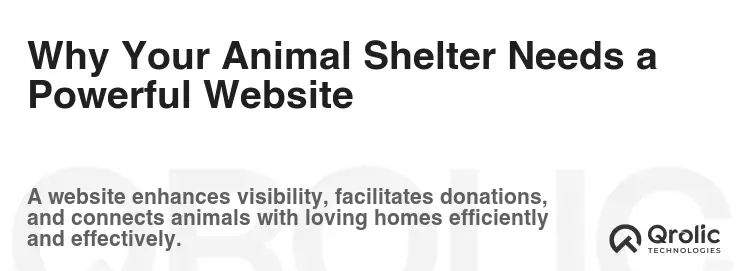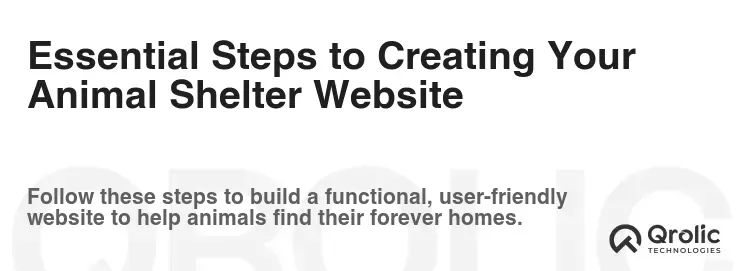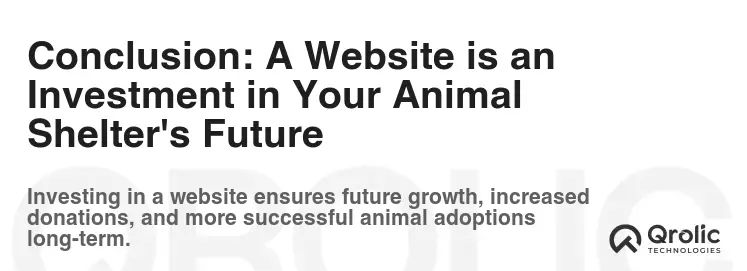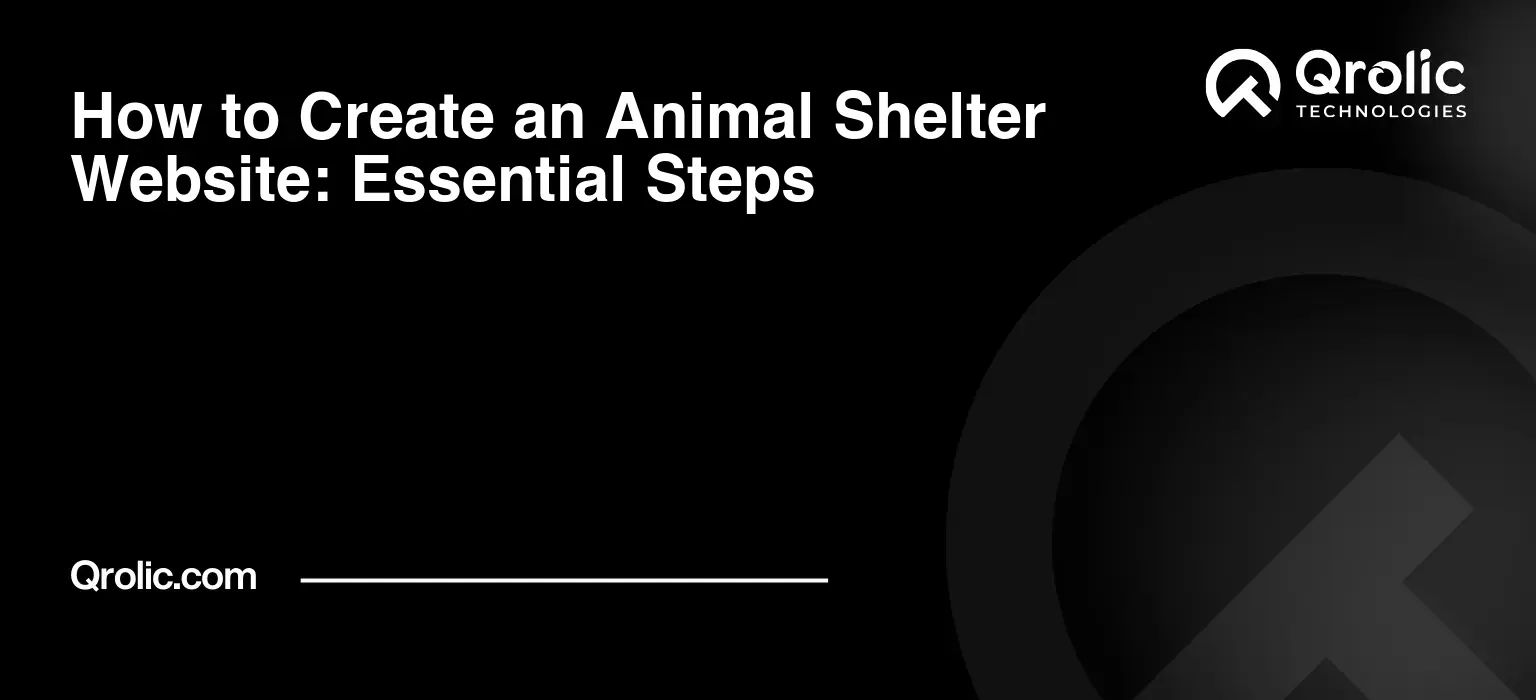Quick Summary:
- Your website expands reach for adoptions, volunteers, and donations.
- Plan goals, choose WordPress, add great content, and use SEO.
- Set up easy donations, integrate social media, and keep it updated.
Table of Contents
- Why Your Animal Shelter Needs a Powerful Website
- Reaching a Wider Audience: Beyond Your Local Community
- Streamlining Operations and Saving Time
- Building Trust and Credibility
- Enhancing Communication and Engagement
- Improved Search Engine Visibility (SEO)
- Essential Steps to Creating Your Animal Shelter Website
- 1. Defining Your Website Goals and Target Audience
- 2. Choosing the Right Domain Name and Hosting Provider
- 3. Selecting a Website Platform (CMS)
- 4. Designing Your Website Layout and User Interface (UI)
- 5. Creating Compelling and Informative Content
- 6. Optimizing Your Website for Search Engines (SEO)
- 7. Setting Up Online Donations and Payment Processing
- 8. Integrating Social Media and Email Marketing
- 9. Testing and Launching Your Website
- 10. Ongoing Maintenance and Updates
- Qrolic Technologies: Your Partner in Creating a Powerful Online Presence
- Conclusion: A Website is an Investment in Your Animal Shelter’s Future
Why Your Animal Shelter Needs a Powerful Website

An effective online presence is no longer optional; it’s essential for animal shelters. Think of your website as a virtual extension of your physical shelter, working 24/7 to connect you with potential adopters, volunteers, donors, and the wider community. But why exactly is a great website so important?
Reaching a Wider Audience: Beyond Your Local Community
Your physical location limits the number of people who can directly interact with your animals and your organization. A website removes those geographical barriers. You can reach animal lovers across your city, state, or even the country, dramatically increasing the chances of finding forever homes for your furry residents.
- Expanding Adoption Reach: Showcase your adoptable animals with captivating photos and detailed descriptions, reaching potential adopters who might not otherwise know about your shelter.
- Attracting Volunteers: Recruit passionate volunteers who can contribute their time and skills to support your mission. A dedicated volunteer page can highlight opportunities and make it easy to sign up.
- Boosting Donations: Provide a secure and convenient platform for online donations, making it easy for supporters to contribute to your cause. Explain how donations help animals in need, fostering trust and encouraging generosity.
- Building Brand Awareness: Increase awareness of your animal shelter and its mission through informative content, success stories, and compelling visuals. Establish your organization as a trusted resource for animal welfare.
Streamlining Operations and Saving Time
A well-designed website can automate many routine tasks, freeing up your staff to focus on more important things – like caring for the animals.
- Online Adoption Applications: Simplify the adoption process with online applications, allowing potential adopters to submit their information conveniently.
- Volunteer Registration: Manage volunteer sign-ups efficiently with online registration forms, saving time and paperwork.
- Event Management: Promote upcoming events, such as adoption days and fundraisers, with detailed information and online registration options.
- Answering FAQs: Provide answers to frequently asked questions about adoption, volunteering, donations, and other topics, reducing the number of phone calls and emails your staff receives.
- Centralized Information Hub: Act as a central place for everything animal related.
Building Trust and Credibility
A professional website instills confidence in your organization, demonstrating your commitment to animal welfare and responsible management.
- Transparency and Accountability: Share your organization’s mission, values, and financial information to build trust with donors and supporters.
- Success Stories and Testimonials: Showcase heartwarming adoption stories and positive testimonials from adopters and volunteers to demonstrate the impact of your work.
- Professional Design and Content: A well-designed website with high-quality content reflects positively on your organization and reinforces your credibility.
- Highlighting Credentials: Showcase the qualifications and experience of your staff and volunteers to demonstrate your expertise in animal care.
- Contact Information and Physical Address: Ensuring the shelter contact information and physical address are easily accessible creates reassurance.
Enhancing Communication and Engagement
A website facilitates ongoing communication with your community, keeping them informed about your activities and fostering a sense of connection.
- News and Updates: Share regular updates on your activities, including adoption successes, fundraising campaigns, and upcoming events.
- Blog Posts and Articles: Publish informative content about animal care, responsible pet ownership, and other relevant topics to educate and engage your audience.
- Social Media Integration: Integrate your website with your social media platforms to share content, promote events, and engage with your followers.
- Email Newsletter Sign-Up: Collect email addresses and send out regular newsletters to keep your supporters informed and engaged.
- Interactive Elements: Use quizzes, polls, and other interactive elements to engage visitors and gather feedback.
Improved Search Engine Visibility (SEO)
A well-optimized website can significantly improve your visibility in search engine results, making it easier for potential adopters, volunteers, and donors to find you online. This is especially important for nonprofit design.
- Keyword Optimization: Use relevant keywords throughout your website content to improve your search engine ranking for terms related to animal shelters, adoption, and animal welfare.
- Mobile-Friendly Design: Ensure your website is responsive and optimized for mobile devices, as a significant portion of online searches are conducted on smartphones and tablets.
- Fast Loading Speed: Optimize your website for speed to improve user experience and search engine ranking.
- High-Quality Content: Create informative and engaging content that is valuable to your target audience.
- Link Building: Acquire backlinks from other reputable websites to improve your website’s authority and search engine ranking.
Essential Steps to Creating Your Animal Shelter Website

Now that you understand the importance of a website, let’s dive into the essential steps of creating one that effectively serves your animal shelter’s needs.
1. Defining Your Website Goals and Target Audience
Before you start building your website, take some time to define your goals and identify your target audience. This will help you make informed decisions about the design, content, and functionality of your website.
- What are your primary goals? Do you want to increase adoptions, recruit more volunteers, boost donations, or raise awareness of your organization?
- Who is your target audience? Are you primarily targeting local residents, families with children, seniors, or a specific demographic?
- What information are they looking for? What are the most common questions people ask about your animal shelter?
- What actions do you want them to take? Do you want them to adopt an animal, volunteer their time, donate money, or sign up for your newsletter?
Once you have a clear understanding of your goals and target audience, you can begin to plan your website content and design accordingly.
2. Choosing the Right Domain Name and Hosting Provider
Your domain name is your website’s address on the internet. It should be easy to remember, relevant to your organization, and available to register. Your hosting provider is the company that stores your website’s files and makes them accessible to visitors.
-
Domain Name:
- Choose a domain name that is short, memorable, and easy to spell.
- Include relevant keywords, such as “animal shelter,” “rescue,” or your city or region.
- Consider using a “.org” extension, which is commonly used by nonprofit organizations.
- Check the availability of your desired domain name and register it through a reputable domain registrar.
-
Hosting Provider:
- Choose a hosting provider that offers reliable service, fast loading speeds, and good customer support.
- Consider shared hosting, VPS hosting, or dedicated hosting, depending on your website’s needs and budget.
- Look for a hosting provider that offers features such as SSL certificates, backups, and security updates.
- Read reviews and compare prices before making a decision.
- Nonprofits may be eligible for discounted or free hosting. Check with providers like Bluehost, DreamHost, and SiteGround.
3. Selecting a Website Platform (CMS)
A content management system (CMS) allows you to create and manage your website content without needing to know how to code. There are several popular CMS options available, each with its own strengths and weaknesses.
- wordpress: The most popular CMS, WordPress is a versatile platform that offers a wide range of themes, plugins, and customization options. It’s relatively easy to use, even for beginners, and has a large and active community of users and developers. For nonprofit design, WordPress offers many tailored themes and plugins.
- Joomla: Another popular CMS, Joomla is a powerful platform that is well-suited for complex websites with advanced features. It has a steeper learning curve than WordPress, but it offers more flexibility and control.
- Drupal: A highly flexible and scalable CMS, Drupal is often used for large, complex websites with demanding requirements. It requires more technical expertise than WordPress or Joomla, but it offers unparalleled customization options.
- Wix & Squarespace: User-friendly platforms with drag-and-drop interfaces, suitable for beginners. However, they offer less flexibility than WordPress. While easier to use initially, they may not scale as well as your needs grow.
Recommendation: For most animal shelters, WordPress is the best choice. It’s easy to use, highly customizable, and offers a wide range of themes and plugins specifically designed for nonprofit organizations. Plus, it is SEO friendly.
4. Designing Your Website Layout and User Interface (UI)
Your website’s layout and user interface (UI) play a crucial role in attracting and engaging visitors. A well-designed website is easy to navigate, visually appealing, and optimized for usability.
- Clear Navigation: Make it easy for visitors to find the information they are looking for by using clear and intuitive navigation menus.
- Visually Appealing Design: Use high-quality images, attractive colors, and a consistent design style to create a visually appealing website.
- Mobile-Friendly Design: Ensure your website is responsive and optimized for mobile devices.
- Call to Actions: Use clear and compelling call to actions to encourage visitors to take desired actions, such as adopting an animal, volunteering, or donating.
- Whitespace: Use whitespace effectively to create a clean and uncluttered design that is easy on the eyes.
- Accessibility: Ensure your website is accessible to people with disabilities by following accessibility guidelines (WCAG).
Key Pages to Include:
- Homepage: The first impression is key. Feature heartwarming photos of animals, a clear mission statement, and prominent calls to action.
- Adoptable Animals: A dedicated page showcasing your adoptable animals with high-quality photos, detailed descriptions, and adoption information. Make sure this section is easily searchable with filter options for breed, age, size and gender.
- Adoption Process: A clear and concise explanation of the adoption process, including requirements, fees, and application instructions.
- Volunteer Opportunities: A page detailing volunteer opportunities and how to sign up.
- Donate: A secure and user-friendly donation page with various giving options.
- About Us: Information about your animal shelter’s mission, history, staff, and values.
- Contact Us: Contact information, including phone number, email address, physical address, and a contact form.
- Success Stories: Share heartwarming stories of adoptions and rescues to inspire and engage visitors.
- Blog: Regularly publish informative content about animal care, responsible pet ownership, and other relevant topics.
- Events: Showcase upcoming events, such as adoption days and fundraisers.
5. Creating Compelling and Informative Content
Your website’s content is what engages visitors and provides them with the information they are looking for. It should be well-written, informative, and optimized for search engines.
- High-Quality Images: Use high-quality images of your animals and your shelter to create a visually appealing website.
- Detailed Descriptions: Provide detailed descriptions of your adoptable animals, including their personalities, medical history, and special needs.
- Informative Articles: Publish informative articles about animal care, responsible pet ownership, and other relevant topics.
- Compelling Stories: Share heartwarming stories of adoptions and rescues to inspire and engage visitors.
- Keyword Optimization: Use relevant keywords throughout your website content to improve your search engine ranking.
Content Ideas:
- Animal Profiles: Create detailed profiles for each adoptable animal, including photos, videos, and personality descriptions.
- Adoption Tips: Offer tips on how to prepare for adopting a pet, how to choose the right pet for your family, and how to care for your new pet.
- Volunteer Stories: Share stories from your volunteers about their experiences working at the animal shelter.
- Fundraising Campaigns: Highlight your fundraising campaigns and explain how donations help animals in need.
- Animal Care Guides: Create guides on topics such as pet nutrition, grooming, and training.
- Local Animal Laws: Provide information on local animal laws and regulations.
6. Optimizing Your Website for Search Engines (SEO)
Search engine optimization (SEO) is the process of optimizing your website to rank higher in search engine results. This will make it easier for potential adopters, volunteers, and donors to find your animal shelter online.
- Keyword Research: Identify the keywords that your target audience is using to search for animal shelters and related information.
- On-Page Optimization: Optimize your website content and code for your target keywords, including title tags, meta descriptions, headings, and image alt text.
- Off-Page Optimization: Build backlinks from other reputable websites to improve your website’s authority and search engine ranking.
- Technical SEO: Optimize your website’s technical aspects, such as site speed, mobile-friendliness, and XML sitemaps, to improve its crawlability and indexability.
- Local SEO: Optimize your website for local search by claiming your Google My Business listing and using local keywords in your content.
SEO Best Practices for Animal Shelter Websites:
- Use relevant keywords: Incorporate keywords such as “animal shelter,” “pet adoption,” “dog rescue,” “cat adoption,” and your city or region throughout your website content.
- Optimize image alt text: Use descriptive alt text for all images on your website, including keywords where appropriate.
- Create a blog: Regularly publish informative and engaging blog posts about animal care, adoption, and other relevant topics.
- Build backlinks: Reach out to other animal-related websites and organizations to request backlinks.
- Get listed in online directories: Submit your website to online directories such as Yelp, Google My Business, and local business directories.
- Monitor your SEO performance: Track your website’s search engine ranking and traffic using tools like Google Analytics and Google Search Console.
7. Setting Up Online Donations and Payment Processing
Making it easy for people to donate online is crucial for supporting your animal shelter’s mission. You’ll need to set up a secure online donation system and integrate it with your website.
- Choose a Payment Processor: Select a payment processor that is reliable, secure, and offers reasonable fees. Popular options include PayPal, Stripe, and Donorbox.
- Create a Donation Form: Design a user-friendly donation form that is easy to fill out and clearly explains how donations will be used.
- Offer Multiple Giving Options: Provide various giving options, such as one-time donations, recurring donations, and memorial donations.
- Secure Donation Processing: Ensure that your donation processing system is secure and complies with PCI DSS standards.
- Thank You Page and Email: Create a thank you page and send a thank you email to donors to acknowledge their contribution and express your gratitude.
Tips for Increasing Online Donations:
- Tell compelling stories: Share heartwarming stories of animals who have been helped by donations.
- Show the impact of donations: Explain how donations are used to provide food, shelter, medical care, and other essential services for animals.
- Make it easy to donate: Provide a clear and prominent “Donate” button on your website and make the donation process as simple as possible.
- Offer incentives: Consider offering incentives for donations, such as a free gift or a chance to win a prize.
- Promote your donation page: Share your donation page on social media, in email newsletters, and in other marketing materials.
8. Integrating Social Media and Email Marketing
Social media and email marketing are powerful tools for promoting your animal shelter, engaging with your community, and driving traffic to your website.
- Social Media Integration: Integrate your website with your social media platforms to share content, promote events, and engage with your followers.
- Social Sharing Buttons: Add social sharing buttons to your website content to make it easy for visitors to share your content on social media.
- Email Newsletter Sign-Up: Collect email addresses and send out regular newsletters to keep your supporters informed and engaged.
- Email Marketing Campaigns: Create email marketing campaigns to promote adoption events, fundraising campaigns, and other important initiatives.
Social Media Strategies for Animal Shelters:
- Share adorable photos and videos of your animals: This is the most effective way to attract attention and engage your followers.
- Tell heartwarming stories: Share stories of adoptions, rescues, and other positive outcomes.
- Promote events and fundraising campaigns: Use social media to spread the word about your events and fundraising campaigns.
- Engage with your followers: Respond to comments and questions, and participate in relevant conversations.
- Run contests and giveaways: This is a great way to generate excitement and increase engagement.
- Use relevant hashtags: Use hashtags such as #adoptdontshop, #animalrescue, #petsforadoption, and your city or region.
Email Marketing Tips for Animal Shelters:
- Build an email list: Collect email addresses through your website, social media, and in-person events.
- Segment your email list: Segment your email list based on interests, demographics, and engagement level.
- Create compelling email content: Write engaging email subject lines and create informative and visually appealing email content.
- Personalize your emails: Personalize your emails to make them more relevant to your recipients.
- Track your email performance: Monitor your email open rates, click-through rates, and conversion rates to measure the effectiveness of your campaigns.
9. Testing and Launching Your Website
Before you launch your website, it’s important to thoroughly test it to ensure that everything is working properly.
- Test all links: Make sure all links on your website are working and that they lead to the correct pages.
- Test all forms: Test all forms on your website, such as contact forms, adoption applications, and donation forms, to ensure that they are submitting correctly.
- Test your website on different devices and browsers: Make sure your website is responsive and that it looks and functions properly on different devices and browsers.
- Check for errors: Use a website validator to check for errors in your website’s code.
- Get feedback: Ask friends, family, and colleagues to review your website and provide feedback.
Once you have thoroughly tested your website and made any necessary corrections, you can launch it to the public.
- Announce your website launch: Share the news about your website launch on social media, in email newsletters, and in other marketing materials.
- Monitor your website traffic: Track your website traffic using tools like Google Analytics to see how your website is performing.
- Make updates and improvements: Regularly update your website content and make improvements based on user feedback and analytics data.
10. Ongoing Maintenance and Updates
Your website is not a “set it and forget it” project. It requires ongoing maintenance and updates to ensure that it remains secure, functional, and relevant.
- Keep your CMS and plugins up to date: Regularly update your CMS and plugins to patch security vulnerabilities and improve performance.
- Back up your website regularly: Back up your website regularly to protect your data in case of a server crash or other disaster.
- Monitor your website security: Monitor your website for security threats and take steps to protect it from hackers.
- Update your website content: Regularly update your website content to keep it fresh and relevant.
- Analyze your website analytics: Analyze your website analytics data to identify areas for improvement.
Qrolic Technologies: Your Partner in Creating a Powerful Online Presence

At Qrolic Technologies (https://qrolic.com/), we understand the unique challenges faced by animal shelters. We can help you create a website that is not only visually appealing and user-friendly but also optimized for search engines and designed to achieve your specific goals.
Our services include:
- Website Design and Development: Custom website design and development tailored to your animal shelter’s needs.
- SEO Optimization: Comprehensive SEO services to improve your website’s search engine ranking and drive more traffic.
- Content Creation: Engaging and informative content creation to attract and retain visitors.
- Social Media Marketing: Social media management and marketing to promote your animal shelter and engage with your community.
- Online Donation Setup: Secure and user-friendly online donation system setup to facilitate fundraising.
- Website Maintenance and Support: Ongoing website maintenance and support to ensure that your website remains secure, functional, and up-to-date.
We are passionate about helping animal shelters achieve their missions. Contact us today to learn more about how we can help you create a powerful online presence.
Conclusion: A Website is an Investment in Your Animal Shelter’s Future

Creating a website for your animal shelter is an investment that will pay off in many ways. A well-designed and optimized website can help you reach a wider audience, streamline operations, build trust and credibility, enhance communication and engagement, and ultimately save more animals lives. By following the essential steps outlined in this guide, you can create a website that effectively serves your animal shelter’s needs and helps you achieve your mission. A robust online presence is critical, and implementing these essential steps with careful consideration of nonprofit design principles will dramatically improve your animal shelter’s success.






